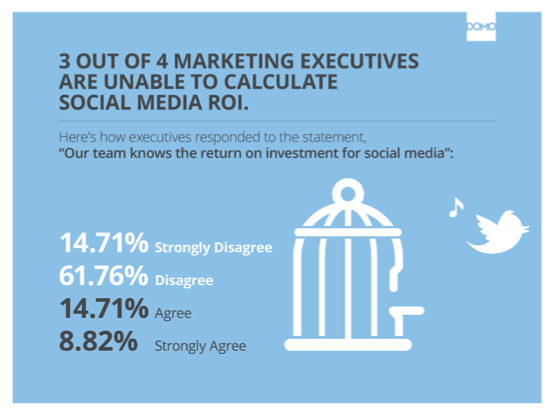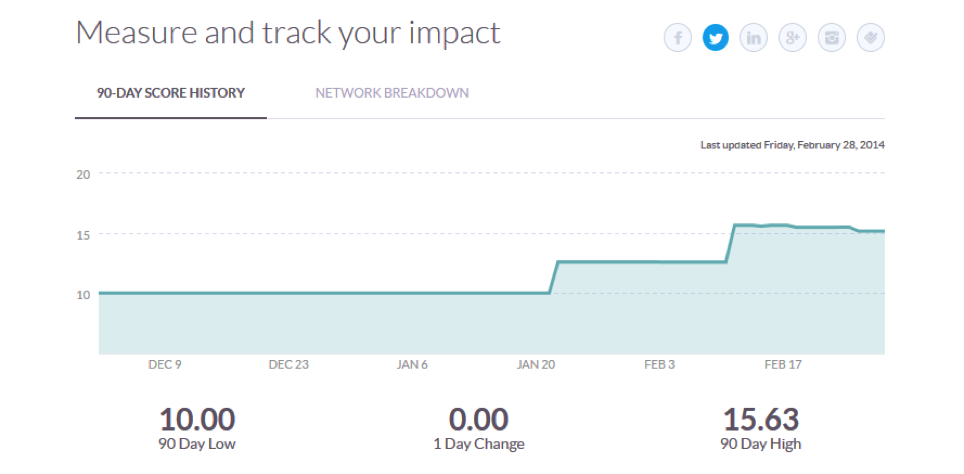As a marketer, return on investment defines the success of a campaign. Without ROI, it can be difficult to report the success or failure of a campaign, especially when it comes to social media.
If your company is spending money on social media marketing, they’ll want to see the return on investment (ROI).
Unfortunately, many marketers can’t measure ROI on their social media marketing efforts.
According to a study of marketing experts performed by Domo, 3 out of 4 marketing experts can’t measure social media ROI.
And without understanding ROI, it’s hard to justify spending money on social media marketing.
 So if you’ve struggled to calculate ROI for your social media efforts, let’s look at the basic, but vital, aspects of social media marketing ROI.
So if you’ve struggled to calculate ROI for your social media efforts, let’s look at the basic, but vital, aspects of social media marketing ROI.
1/ Likes and Follows: Measuring Engagement
The simplest way to measure social media ROI involves measuring your followers on Twitter, your likes on Facebook, and all other social media sites that you’re associated with.
Keeping a spreadsheet to track the growth of your followers and fans can help you identify trends and the success of specific campaigns.
Tracking the total number of social media conversions you made during a particular campaign (followers on Twitter, likes on Facebook, etc.) also gives you relevant data you can share with your boss, explaining that you brought X amount of new followers to your company’s social media platforms because of your campaign.
Tracking engagement through shares on Facebook, retweets on Twitter, and other social media shares is also vital to explaining success.
Simple tools like Facebook Insights and Twitter Analytics allow you to track how successful a specific post was, which can be helpful in pinpointing the content your customers respond best to.
If you’re looking to measure the success of a specific keyword, hashtag, or unique topic, there are many tools to help you monitor such as Brandwatch (this site), GroSocial and Keyhole. They explain specific trends on Facebook, Twitter, and other social networks for the keywords you enter.
While this type of data is relevant and easy to measure, it should not be the only measure of social media ROI.

2/ Understanding Click-through Rate and Impressions
Click-through rate is most commonly used to measure the success rate of ads on social media, so get familiar with this concept if you’re looking to run promotions on social media sites.
Click-through rate, or volume of click-throughs, is vital to proving that your brand is visible on social media. Click-through rate, simply stated, is the ratio of how often people who see your ad, keyword, or brand on a particular site actually click and follow it.
Or in a simple formula, CTR = Clicks ÷ Views (or Impressions).
Almost every social media site gives access to these measurements through their ad reporting sections.
Download a CSV file of these metrics, combine it with your other social media sites, and easily view the click-through rate and impressions for each specific social media site.
If you haven’t yet stepped into the realm of paid ads, simply use Google Analytics to track click-through rate and impressions of other desired pages.
3/ Tracking Influence
 Measuring influence on social media platforms can be difficult, and it’s been the topic of debate in much of the industry.
Measuring influence on social media platforms can be difficult, and it’s been the topic of debate in much of the industry.
It’s not easy to assign a specific number to your company’s influence, but some tools have attempted to do so. Klout, Social Authority and Brandwatch are popular tools that measure “influence” in your industry.
It’s helpful to see how people interact with what you share on social media, although tracking influence is still an imperfect art.
Before you rely on a tool like Klout to measure your influence, understand what goes into creating your Klout score.
4/ Measuring Sentiment
Another difficult but important metric to track is sentiment. Sentiment is the general feeling and tone of conversations surrounding your brand, company, or product.
It can be painstaking to track sentiment manually, but it is possible.
Tools like HootSuite, Klout, Buffer and Social Flow allow you to connect many of your social media accounts and track what’s happening on each account from one dashboard.
Platforms that track sentiment automatically are becoming increasingly popular.
There are many great tools that include some level of sentiment tracking like Brandwatch, Social Mention and others.
The beauty of these tools is that they also allow you to track what people are saying about you, which people are talking about you, and the general attitude towards your brand or product.
All this data can be overwhelming and difficult to track at times, as necessary as it is.
Once you’ve outgrown the beginning stages of social media analytics, it’s worth investing in a dashboard that provides real-time feedback from all your social media accounts.
A customizable dashboard that provides the specific data your marketing department needs is vital as your social media marketing efforts expand.
Automating all this data through one centralized platform will increase opportunity to analyze future trends and opportunities for your social media marketing.
Calculating social media ROI and collecting all this data can open doors to measuring and improving your social media marketing. But all these numbers only become useful when they are applied to improving your social media efforts.
Don’t let reporting the ROI of your social media activity get in the way of creating quality content. Quality social content paired with useful social media ROI is the recipe for success.



